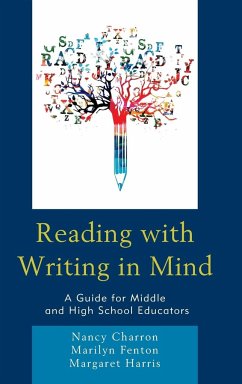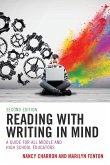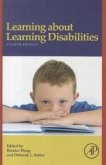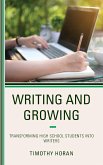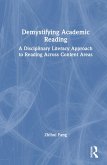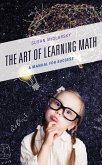Nancy Charron, Marilyn Fenton, Margaret Harris
Reading with Writing in Mind
A Guide for Middle and High School Educators
Nancy Charron, Marilyn Fenton, Margaret Harris
Reading with Writing in Mind
A Guide for Middle and High School Educators
- Gebundenes Buch
- Merkliste
- Auf die Merkliste
- Bewerten Bewerten
- Teilen
- Produkt teilen
- Produkterinnerung
- Produkterinnerung
- Weitere 7 Ausgaben:
- Gebundenes Buch
- Broschiertes Buch
- Broschiertes Buch
- eBook, ePUB
- eBook, ePUB
- eBook, PDF
- eBook, PDF
This book demonstrates effective teaching practices that facilitate all students’ written language development and improve attitudes toward writing in grades 6 - 12. All teachers need to be involved in raising the literacy bar. This book provides practical and classroom-tested activities and strategies that promote success for all learners.
Andere Kunden interessierten sich auch für
![Reading with Writing in Mind Reading with Writing in Mind]() Nancy CharronReading with Writing in Mind35,99 €
Nancy CharronReading with Writing in Mind35,99 €![Reading with Writing in Mind Reading with Writing in Mind]() Nancy CharronReading with Writing in Mind83,99 €
Nancy CharronReading with Writing in Mind83,99 €![Learning About Learning Disabilities Learning About Learning Disabilities]() Learning About Learning Disabilities57,99 €
Learning About Learning Disabilities57,99 €![Writing and Growing Writing and Growing]() Timothy HoranWriting and Growing37,99 €
Timothy HoranWriting and Growing37,99 €![Writing and Growing Writing and Growing]() Timothy HoranWriting and Growing78,99 €
Timothy HoranWriting and Growing78,99 €![Demystifying Academic Reading Demystifying Academic Reading]() Zhihui FangDemystifying Academic Reading168,99 €
Zhihui FangDemystifying Academic Reading168,99 €![Art of Learning Math Art of Learning Math]() Susan MidlarskyArt of Learning Math33,99 €
Susan MidlarskyArt of Learning Math33,99 €-
-
-
This book demonstrates effective teaching practices that facilitate all students’ written language development and improve attitudes toward writing in grades 6 - 12. All teachers need to be involved in raising the literacy bar. This book provides practical and classroom-tested activities and strategies that promote success for all learners.
Produktdetails
- Produktdetails
- Verlag: Rowman & Littlefield Publishers
- Seitenzahl: 142
- Erscheinungstermin: 30. November 2017
- Englisch
- Abmessung: 235mm x 157mm x 12mm
- Gewicht: 367g
- ISBN-13: 9781475840049
- ISBN-10: 1475840047
- Artikelnr.: 48894774
- Herstellerkennzeichnung
- Libri GmbH
- Europaallee 1
- 36244 Bad Hersfeld
- gpsr@libri.de
- Verlag: Rowman & Littlefield Publishers
- Seitenzahl: 142
- Erscheinungstermin: 30. November 2017
- Englisch
- Abmessung: 235mm x 157mm x 12mm
- Gewicht: 367g
- ISBN-13: 9781475840049
- ISBN-10: 1475840047
- Artikelnr.: 48894774
- Herstellerkennzeichnung
- Libri GmbH
- Europaallee 1
- 36244 Bad Hersfeld
- gpsr@libri.de
By Nancy Charron; Marilyn Fenton and Margaret Harris
Preface
Introduction
Chapter 1: Reading to Improve Student Writing
Activity 1.1: Take Time to Notice-Looking and Learning
Activity 1.2: Take Time to Notice-An Artist's Choices
Activity 1.3: Take Time to Notice-Comparison of Two Works of Art
Activity 1.4: Noticing the Writer's Choices-Reading Poems
Activity 1.5: Noticing the Writer's Choices-Reading Fiction
Activity 1.6: Noticing the Writer's Choices-Reading Nonfiction
Activity 1.7: Determining Connotation vs. Denotation-Taking the Temperature
of Words
Activity 1.8: Identifying Three Kinds of Questions
Activity 1.9: Using the I-Search Paper
Chapter 2: Reading and Writing in the Content Areas
Activity 2.1: Using the SOAPSTone Strategy
Activity 2.2: Role-playing
Activity 2.3: Using Primary Documents
Activity 2.4: Using Letters, Diaries, and Other Primary Sources
Activity 2.5: Applying the Concept of Essential Questions in Content Areas
Activity 2.6: Implementing Socratic Seminars
Activity 2.7: Reviewing the Textbook
Activity 2.8: Journaling
Activity 2.9: Authentic Content Area Writing
Chapter 3: Developing Focus and Logic through the Essay
Activity 3.1: How Meaning is Constructed in E.B. White's "Once More to the
Lake"
Activity 3.2: Form Supports Meaning
Activity 3.3: Conversion of a Narrative to an Essay
Activity 3.4: Finding Significance in Literature
Activity 3.5: Brainstorming in Response to Essential Questions
Chapter 4: Reading for Persuasive Writing: The Argument
Activity 4.1: Checklist for Close-Reading
Activity 4.2: The Face-Off
Activity 4.3: The Scaffolded Oral Presentation
Activity 4.4: A Panel Discussion
Activity 4.5: Staging the Trial
Activity 4.6: Defending Preference
Chapter 5: Learning to Write by Reading Poetry
Activity 5.1: Less is More
Activity 5.2: "Found" Poetry
Activity 5.3: From Prose to Poetry
Activity 5.4: Playing with Meter
Activity 5.5: Learning from e.e. cummings
Activity 5.6: Poems Using Metaphor
Activity 5.7: Letter Poem
Activity 5.8: History and Poetry
Activity 5.9: Songs as Poetry
Activity 5:10: Inference
Chapter 6: Providing Literacy Access to All Students
Chapter 7: Reading and Reflecting on One's Own Writing
Chapter 8: Closing the Literacy Loop
References
About the Authors
Introduction
Chapter 1: Reading to Improve Student Writing
Activity 1.1: Take Time to Notice-Looking and Learning
Activity 1.2: Take Time to Notice-An Artist's Choices
Activity 1.3: Take Time to Notice-Comparison of Two Works of Art
Activity 1.4: Noticing the Writer's Choices-Reading Poems
Activity 1.5: Noticing the Writer's Choices-Reading Fiction
Activity 1.6: Noticing the Writer's Choices-Reading Nonfiction
Activity 1.7: Determining Connotation vs. Denotation-Taking the Temperature
of Words
Activity 1.8: Identifying Three Kinds of Questions
Activity 1.9: Using the I-Search Paper
Chapter 2: Reading and Writing in the Content Areas
Activity 2.1: Using the SOAPSTone Strategy
Activity 2.2: Role-playing
Activity 2.3: Using Primary Documents
Activity 2.4: Using Letters, Diaries, and Other Primary Sources
Activity 2.5: Applying the Concept of Essential Questions in Content Areas
Activity 2.6: Implementing Socratic Seminars
Activity 2.7: Reviewing the Textbook
Activity 2.8: Journaling
Activity 2.9: Authentic Content Area Writing
Chapter 3: Developing Focus and Logic through the Essay
Activity 3.1: How Meaning is Constructed in E.B. White's "Once More to the
Lake"
Activity 3.2: Form Supports Meaning
Activity 3.3: Conversion of a Narrative to an Essay
Activity 3.4: Finding Significance in Literature
Activity 3.5: Brainstorming in Response to Essential Questions
Chapter 4: Reading for Persuasive Writing: The Argument
Activity 4.1: Checklist for Close-Reading
Activity 4.2: The Face-Off
Activity 4.3: The Scaffolded Oral Presentation
Activity 4.4: A Panel Discussion
Activity 4.5: Staging the Trial
Activity 4.6: Defending Preference
Chapter 5: Learning to Write by Reading Poetry
Activity 5.1: Less is More
Activity 5.2: "Found" Poetry
Activity 5.3: From Prose to Poetry
Activity 5.4: Playing with Meter
Activity 5.5: Learning from e.e. cummings
Activity 5.6: Poems Using Metaphor
Activity 5.7: Letter Poem
Activity 5.8: History and Poetry
Activity 5.9: Songs as Poetry
Activity 5:10: Inference
Chapter 6: Providing Literacy Access to All Students
Chapter 7: Reading and Reflecting on One's Own Writing
Chapter 8: Closing the Literacy Loop
References
About the Authors
Preface
Introduction
Chapter 1: Reading to Improve Student Writing
Activity 1.1: Take Time to Notice-Looking and Learning
Activity 1.2: Take Time to Notice-An Artist's Choices
Activity 1.3: Take Time to Notice-Comparison of Two Works of Art
Activity 1.4: Noticing the Writer's Choices-Reading Poems
Activity 1.5: Noticing the Writer's Choices-Reading Fiction
Activity 1.6: Noticing the Writer's Choices-Reading Nonfiction
Activity 1.7: Determining Connotation vs. Denotation-Taking the Temperature
of Words
Activity 1.8: Identifying Three Kinds of Questions
Activity 1.9: Using the I-Search Paper
Chapter 2: Reading and Writing in the Content Areas
Activity 2.1: Using the SOAPSTone Strategy
Activity 2.2: Role-playing
Activity 2.3: Using Primary Documents
Activity 2.4: Using Letters, Diaries, and Other Primary Sources
Activity 2.5: Applying the Concept of Essential Questions in Content Areas
Activity 2.6: Implementing Socratic Seminars
Activity 2.7: Reviewing the Textbook
Activity 2.8: Journaling
Activity 2.9: Authentic Content Area Writing
Chapter 3: Developing Focus and Logic through the Essay
Activity 3.1: How Meaning is Constructed in E.B. White's "Once More to the
Lake"
Activity 3.2: Form Supports Meaning
Activity 3.3: Conversion of a Narrative to an Essay
Activity 3.4: Finding Significance in Literature
Activity 3.5: Brainstorming in Response to Essential Questions
Chapter 4: Reading for Persuasive Writing: The Argument
Activity 4.1: Checklist for Close-Reading
Activity 4.2: The Face-Off
Activity 4.3: The Scaffolded Oral Presentation
Activity 4.4: A Panel Discussion
Activity 4.5: Staging the Trial
Activity 4.6: Defending Preference
Chapter 5: Learning to Write by Reading Poetry
Activity 5.1: Less is More
Activity 5.2: "Found" Poetry
Activity 5.3: From Prose to Poetry
Activity 5.4: Playing with Meter
Activity 5.5: Learning from e.e. cummings
Activity 5.6: Poems Using Metaphor
Activity 5.7: Letter Poem
Activity 5.8: History and Poetry
Activity 5.9: Songs as Poetry
Activity 5:10: Inference
Chapter 6: Providing Literacy Access to All Students
Chapter 7: Reading and Reflecting on One's Own Writing
Chapter 8: Closing the Literacy Loop
References
About the Authors
Introduction
Chapter 1: Reading to Improve Student Writing
Activity 1.1: Take Time to Notice-Looking and Learning
Activity 1.2: Take Time to Notice-An Artist's Choices
Activity 1.3: Take Time to Notice-Comparison of Two Works of Art
Activity 1.4: Noticing the Writer's Choices-Reading Poems
Activity 1.5: Noticing the Writer's Choices-Reading Fiction
Activity 1.6: Noticing the Writer's Choices-Reading Nonfiction
Activity 1.7: Determining Connotation vs. Denotation-Taking the Temperature
of Words
Activity 1.8: Identifying Three Kinds of Questions
Activity 1.9: Using the I-Search Paper
Chapter 2: Reading and Writing in the Content Areas
Activity 2.1: Using the SOAPSTone Strategy
Activity 2.2: Role-playing
Activity 2.3: Using Primary Documents
Activity 2.4: Using Letters, Diaries, and Other Primary Sources
Activity 2.5: Applying the Concept of Essential Questions in Content Areas
Activity 2.6: Implementing Socratic Seminars
Activity 2.7: Reviewing the Textbook
Activity 2.8: Journaling
Activity 2.9: Authentic Content Area Writing
Chapter 3: Developing Focus and Logic through the Essay
Activity 3.1: How Meaning is Constructed in E.B. White's "Once More to the
Lake"
Activity 3.2: Form Supports Meaning
Activity 3.3: Conversion of a Narrative to an Essay
Activity 3.4: Finding Significance in Literature
Activity 3.5: Brainstorming in Response to Essential Questions
Chapter 4: Reading for Persuasive Writing: The Argument
Activity 4.1: Checklist for Close-Reading
Activity 4.2: The Face-Off
Activity 4.3: The Scaffolded Oral Presentation
Activity 4.4: A Panel Discussion
Activity 4.5: Staging the Trial
Activity 4.6: Defending Preference
Chapter 5: Learning to Write by Reading Poetry
Activity 5.1: Less is More
Activity 5.2: "Found" Poetry
Activity 5.3: From Prose to Poetry
Activity 5.4: Playing with Meter
Activity 5.5: Learning from e.e. cummings
Activity 5.6: Poems Using Metaphor
Activity 5.7: Letter Poem
Activity 5.8: History and Poetry
Activity 5.9: Songs as Poetry
Activity 5:10: Inference
Chapter 6: Providing Literacy Access to All Students
Chapter 7: Reading and Reflecting on One's Own Writing
Chapter 8: Closing the Literacy Loop
References
About the Authors

